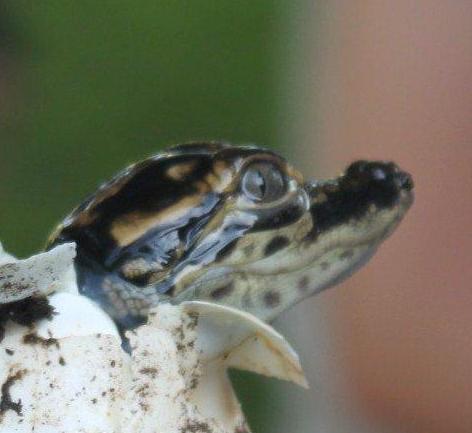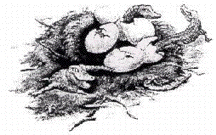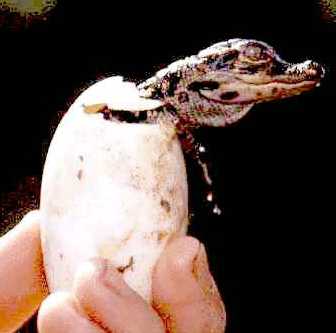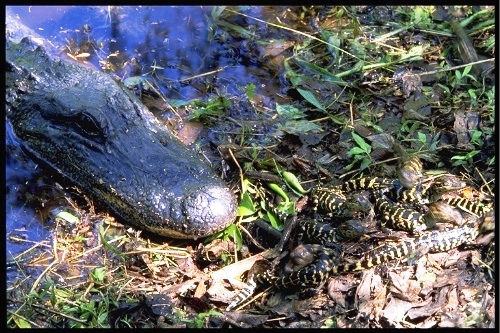 |
|
 |
-
Home - Park
Information - Programs,
Activities & Hikes - We've
Got Gators - Plants &
Animals - Get
Involved -
Members -

Baby Alligators |
|
Young alligators are displayed year ‘round and are released each fall and replaced by new hatchlings. The young are either carefully collected from a pod of hatchlings or hatched from collected eggs. A few of the babies are placed on display in the Nature Center. Some are also kept behind the scenes to be used for educational outreach events. The rest will be placed back with the mother alligator or if need be a different mother. Mother alligators will adopt and protect other babies. If it looks and sounds like a baby alligator she’ll accept it, no questions asked. The animals are kept in the nature center no longer than one year as they will become habituated to human contact if kept longer. At one year they are still young enough to revert back to their natural instincts that include a fear of humans.
Alligator mating season takes place in the spring and nest building starts around the month of June. The mother alligator protects her nest from would-be predators such as raccoons and opossums. Any infestation of fire ants spells imminent disaster for the young. The eggs will be fine until hatching. Not only is the mother keeping an eye out for predators, she is also listening for chirping calls from the nest which is her signal the babies are ready to hatch. (The babies will later use this chirping call as a distress call to the mother.) The mother alligator will carefully dig through the nest helping the babies free themselves from the debris. With the use of an egg tooth, most of the babies are capable of hatching on their own. Others will receive help from Mom. Hatching takes place in a matter of hours, often under the cover of night. Nests are not always visible from park trails. They are usually well hidden away from human activity among the islands in Elm and 40-Acre Lakes. |
|
Baby Alligator Chirping |
|
Alligators lay an average of 45 eggs. About 2/3 of those hatch, and approximately one alligator from each nest will grow to adulthood. Although the mother will keep a close eye on her young most will get eaten by bullfrogs, fish and wading birds, just to name a few. Imagine if all the eggs hatched successfully and grew to adults. We’d be up to our knees in alligators! But with nature’s system, we have perfect balance. One could fairly say that alligators start their lives at the bottom of the chain and those lucky enough to survive to adulthood will take their rightful place at the top. Like all reptiles, baby alligators are hatched fully developed and ready to face the world. With a full set of teeth they are equipped to hunt for their own food which consists mainly of aquatic insects and minnows. As the alligator grows in size, so will its prey. However, alligators, no matter what size, are known to mostly hunt food that they can swallow whole though large animals may take deer, feral pigs or even smaller alligators!
All alligators start out fairly even in length at 7 to 9 inches long at hatching and grow about 1 foot per year for the first 5 years of their lives, reaching maturity at around 5 or 6 years of age. Alligators never stop growing. However, growth-rates slow dramatically in females which usually reach lengths of only about 6 or 7 feet. Males may grow to be as long as 10 or maybe even 12 feet. (Despite popular rumors, the largest alligator ever recorded at the park was a little over 13 & ½ feet long and no large adult male alligators are relocated to the park from surrounding areas, this would upset the balance.) Live animals are used by park staff as teaching tools. Whether in the Nature Center, at an outreach event or interpretive program, visitors have ample opportunities to touch these delicate creatures and learn about their importance in the health and survival of wetland areas in the Southeastern United States. It is important to note that it is illegal to posses any alligator of any size without proper permits. Although baby alligators enter this world cute and harmless, they quickly develop their natural predatory instincts and become dangerous “pets”. Always remember that wild animals do not make good pets. All wildlife within state parks is protected and may not be harmed, fed, or removed. Alligator viewing is best during the milder months of the year. Reptiles prefer days that are also comfortable for most humans. They avoid activity during the heat of the summer months and rainy days. They do not hibernate but instead are torpid during cold or hot spells. Mating activity can be seen or heard from April to late May. When hiking the trails in the wetland areas it is important to be familiar with the park’s alligator etiquette rules which are found on park maps and posted throughout the park. Remember that nature rules the park and you are a guest in her home.
|
|
|
Updated: Jul 13, 2021 |



